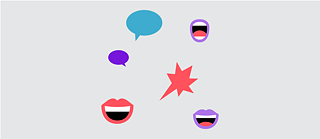Word! The Language Column
Report on a Work in Progress

Everything is miles better abridged – says the poet Arne Rautenberg. Which is an apt watchword for six writers who came together to lay down some rules for their own easy-to-read texts. Hauke Hückstädt reports on the tools used in this literary workshop.
By Hauke Hückstädt
Six writers came together at the Literaturhaus Frankfurt: Olga Grjasnowa, Nora Bossong, Alissa Walser, Kristof Magnusson, Henning Ahrens and Mirko Bonné. The Main was sprawled out in the bend of the riverbed, it seemed an ordinary day in July. And yet this brainstorming session was anything but ordinary. For in this configuration, under these auspices, it was zero hour for us as the midday sun outside pinned short shadows to the ground around buildings, animate figures and things. The idea was to get a handful of renowned contemporary writers to come up with original works in plain, easy-to-read language. As a literary project. As an aesthetic undertaking with ethical ramifications. Our circle of writers was rounded out by Frankfurt journalist Eva Keller, an authority on social inclusion, integration and education policy.
Equal access
We’d already faced resistance. The naysayers, the sceptics, the righteous keepers of the Grail of artistic sovereignty had all come out against it. Fortunately, however, the project was already funded. The City of Frankfurt’s social services wanted it, and the State of Hesse wanted it – and had paid for it. We’ve got to give it a try, we told the shilly-shalliers. The UN has declared that everyone has the right to equal access, we added. And that’s a good resolution. We all believe that poetry is more reliable than any political doctrine or belief system. All the more reason for everyone to partake thereof. We’ll only call it off if we can’t find any writers to sign up for it. But we did find some.Liberating rules
That day in July, the writers got together and laid down some rules. Rules they’d be following themselves in writing a text in plain, easy-to-read language. Not even a dozen rules, all told. Though some did prove to be a bone of contention. One of the writers wanted absolute freedom to punctuate as they pleased, another crusaded for the enlivening effect of varying verb tenses. There was no reason to rule out either proposal. To be sure, these rules had nothing in common with the rules of easy reading and were also miles away from the extensive recommendations for plain language. For an artistic project, they were, in a word, radical: Our texts can be inventive. We shall write texts that take no more than twenty minutes to read aloud. We shall use simple words. We shall write simple sentences. We shall explain any metaphors we use. And so on.Later on, before and after the applause for the first texts to be read aloud to an audience, almost all the participating writers explained their approach in artisanal terms. It was like walking into a workshop, a studio, and finding hardly any of their usual tried and tested secret helpers there to lend a helping hand. The tool kit was almost empty, nothing but pliers, pencil, hammer and paper. Stripped of all tricks of the trade by rules that they had made themselves. This is roughly how the writers described their working process.
They also recounted how liberating it was at some point. To be sure, no one said, “This is it! There’s no going back for me.” But that wasn’t the point anyway. It was about trying a different approach, a new, additional approach, about clearing the way for a new kind of literature. It was about trying to come up with an aesthetic answer to an ethical dilemma: Can there be art for everyone? – No, of course not. There’s no such thing as a book for everyone, a picture, film or song for everyone. Nothing suits everyone. Especially not art. But we did open up the possibility of composing literature that leaves as few readers as possible out in the cold.
Not that small a target group
Who’s it all for? Well, it’s for anyone who’s learning our language. Or for the ambitious German class that want a brief overview of contemporary German literature: they can get to know thirteen writers in one go and, as the next step, compare Nora Bossong's plain-language text with one of her novels. It’s of interest to people who have a hard time concentrating or some physical impairment that makes it hard for them to read for an extended period of time. Alternatively, for those who view language as a laboratory for future poetry. Or those who’ll read anything and everything by Henning Ahrens, for example. Or for people with cognitive limitations, old folks, people afraid of embarking on anything new. Or for people who are finally plucking up the courage to start learning to read, but have outgrown Maya the Bee. After all, one in seven adults in Germany is functionally illiterate.Word! The Language Column
Our column “Word!” appears every two weeks. It is dedicated to language – as a cultural and social phenomenon. How does language develop, what attitude do authors have towards “their” language, how does language shape a society? – Changing columnists – people with a professional or other connection to language – follow their personal topics for six consecutive issues.